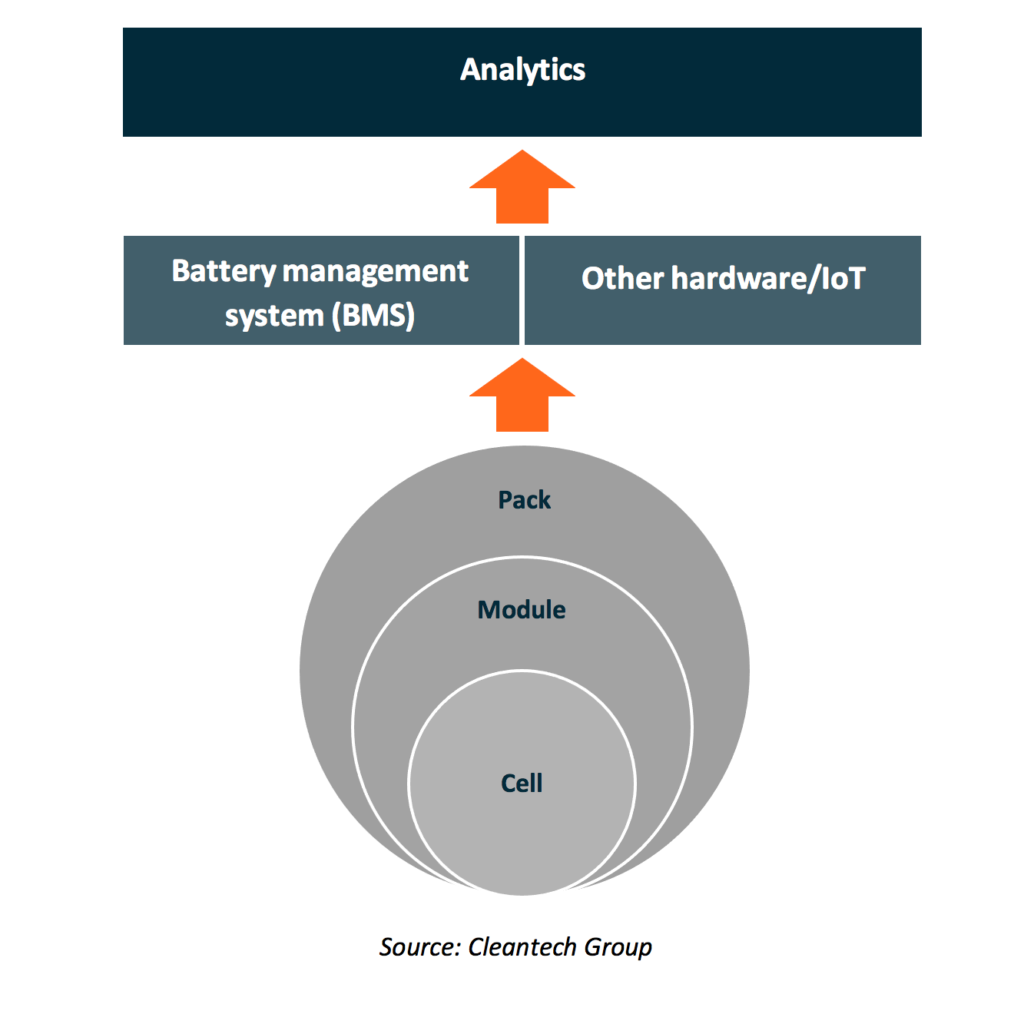Battery Analytics and Diagnostics: How Big Data Makes EV Batteries Smarter, Increases Longevity and Unlocks Second-Life Use
In May, I wrote an article about creating a circular economy for EV batteries as an initial look into the industry. I highly recommend starting with that Insight to provide context on the issues surrounding EV battery materials, including drivers for a circular supply chain and a deeper explanation of circular economy principals.
Since the article was initially posted, the new EU Batteries Directive was proposed as part of the Circular Economy Action Plan. Additionally, many automakers have made significant announcements regarding end-of-life pathways for their batteries. In light of these developments, this follow-up analysis digs deeper into the innovations necessary to reach circularity at scale.
Regulatory Push
As part of the new Batteries Directive, the European Commission has proposed mandatory requirements for all batteries (including automotive), such as:
- Responsible material sourcing
- Minimum recycled material content
- Carbon footprint monitoring
- Performance
- Durability
- Labeling, collection and recycling targets.
The proposed legislation will require all automotive batteries to be collected at the end of their first useful life, define a framework for repurposing EV batteries and require all collected batteries to be recycled with high levels of material recovery. This ambitious legislation will accelerate circularity; along the same trajectory, other countries and regions, such as Australia, Canada and California, are also developing regulations and Extended Producer Responsibility (EPR) for EV batteries.
Although the number of electric vehicles coming off the road is currently low, accelerating market penetration of EV’s will create a major waste problem once these vehicles reach end-of-life. In addition, both the materials and capacity contained in lithium-ion batteries are valuable and governments are looking to retain this value in local economies.
Automaker Activity
OEMs are also transitioning towards more circular battery value chains in tandem with regulatory pushes. Recently, Groupe Renault announced the development of REFACTORY in Flins, the first European factory fully dedicated to a circular economy. The circular economy model will be based on vehicle use (rather than ownership), life extension (through retrofit, reuse and maintenance), repurposing for second life uses and closed-loop recycling.
BYD has been in the recycling and second-life business for a while now, but the Chinese automaker’s efforts are ramping up. The company recently entered a partnership with ITOCHU to develop shipping container-sized energy storage units from used EV batteries to be used for renewable energy and factories across the globe.
Volvo has also been involved in reuse schemes, as have General Motors, Ford, Nissan and others. Currently, due to low volumes, the second-life market for batteries is virtually nonexistent and recycling remains costly, but automakers are testing different technologies and business models in preparation to capture value from the eventual flood of EOL batteries.
Challenges
Pilot-scale battery recycling plants and second-life energy storage projects have been operating for a few years now and key challenges are starting to emerge, including:
- Lengthy and costly processes are needed to determine battery state of health (SoH) after the first life;
- Second life applications (other than EVs) require different use profiles and the lifespan in these applications is unknown;
- Lithium-ion batteries are made by many different manufacturers with different constructions and chemistries; recyclers and refurbishers often do not know what kind of battery they receive or what the capacity (and SoH) of the battery is;
- Transportation of entire batteries is costly and highly-regulated;
- There is no market, currently, for second life batteries due to low volumes coming out of use and uncertainty around performance;
- The market for -and value of -recycled materials is uncertain and volatile.
Collaboration across stakeholders, governments and regions is important in order to create markets for second-life batteries (and materials), share knowledge and develop solutions to many of these challenges; innovation also has a role to play.
Generating Intelligence from a Wealth of Data
These challenges have created space in the market for innovative solutions for battery management, analytics, SoH assessment and refurbishment. During production, testing and in-vehicle use, batteries generate massive amounts of data. Currently, Battery Management Systems (BMS) capture some data (such as current state of charge) but the information is static and gives little insight into the health of the battery, making it difficult to generate actionable insights. Two key goals of innovators are to generate more granular data over a battery’s life (from production to in-vehicle use to second-life systems) and to leverage analytics to make intelligent use of that data by providing a complete picture of a battery’s life.
Battery analytics technology stack

Battery Management (First life)
Battery management systems used during a battery’s first life are becoming more sophisticated and robust, gathering data on a more granular level even down to the cell level, in some cases.
EVChip, an Israel-based startup, has developed a next-generation battery management system using artificial intelligence (AI) to monitor and dynamically control battery architecture at the cell level. Despite massive investments in battery manufacturing to make cells as uniform as possible, cell capacity varies at the time of manufacturing. These differences only expand as the battery is used. The algorithms optimize charging and depletion of each individual cell, maximizing capacity and lifespan of the battery. By having granular data on individual cells, battery repurposing companies can accurately predict the capacity left in the battery, reducing the time and costs associated with EOL battery diagnostics.
Battery Analytics (Production and First life)
Battery analytics platforms and technologies are bringing intelligence into the battery manufacturing process and first life. The intelligence generated by analytics platforms is used to extend the life of batteries, manufacture better batteries, unlock new markets for end-of-life batteries and prevent safety hazards and recalls. Innovators are gathering data in new ways from battery manufacturing, IoT and other hardware and BMS.
Twaice is a Munich-based developer of predictive analytics platforms for batteries using digital twins and cloud-based software. The platform gathers data from BMS, such as voltage and temperature, to assess the current condition of the battery. The digital twin software develops simulation models of batteries, helping OEMs choose the right cells and develop better batteries. In addition to battery intelligence for development and in-vehicle use, Twaice is working with insurance companies and fleets to develop value-add services such as battery aging and residual value assessments.
Feasible is a California-based developer of ultrasound technology and a battery analytics platform that generates high fidelity data on batteries during production and translates it into actionable intelligence. The solution produces data on both the battery state of charge and SoH down to the cell level, allowing cell manufacturers and automakers to produce and select high quality cells to extend the lifetime of batteries.
Battery Diagnostics and Refurbishment (Second Life)
At the end of a battery’s first life (and before it can be used for a second-life application) the capacity and SoH of the battery needs to be determined. Usually this is done by fully cycling the battery (i.e. fully charging and draining the battery). This takes hours and can cost more than the value of the battery. Innovators are focused on bringing down the time and cost needed for SoH assessments, improving the economics of second-life uses.
ReJoule, a southern California-based developer of a battery health assessment process, recently received $2.9 million in grant funding (along with CleanSpark) from the California Energy Commission to validate the capability of second-life batteries to cost-effectively be used for energy storage to integrate renewables into the grid. The company’s battery grading technology reduces the cost of testing battery SoH by dramatically reducing testing time. In a one-minute test, the technology can get within a 5% capacity estimate – a process which usually takes hours.
Business Models and Competition
The main business models in the space are either pure SaaS solutions or SaaS+ hardware component. Pure SaaS platforms tap into existing sources of data, such as BMS, while SaaS + hardware solutions can generate new data. Innovative solutions are targeting different parts of the value chain, from battery production to in-vehicle use, along with different vehicle types, from micromobility to heavy duty vehicles. Customers include battery manufacturers, auto makers, fleet operators and battery repurposers; the value proposition differs across customer segments.
Competition in the space is low and startups are still largely in early stages and at pilot scale. Incumbents, such as Tier 1 component suppliers and auto makers themselves, can potentially compete in the space and develop their own offerings. However, they will likely rely on the expertise of third parties. Relationships with battery manufacturers and OEMs will be key for success in the industry. In addition, solutions which can be easily integrated with existing systems, such as software-based solutions, will have a quicker path to market.


